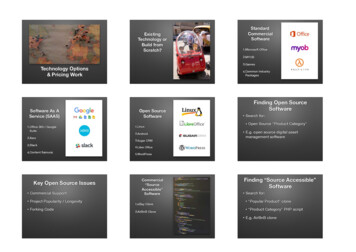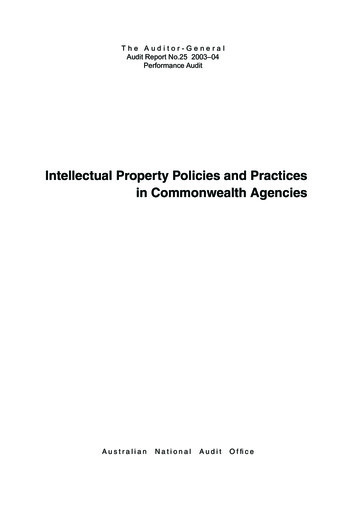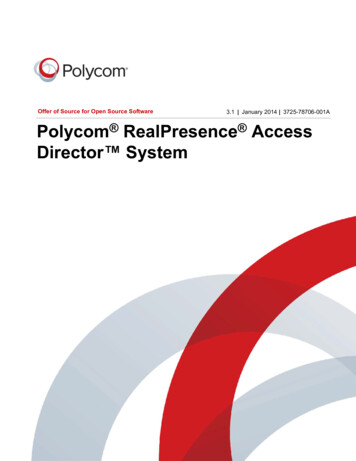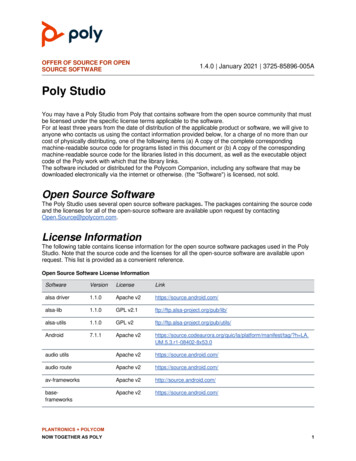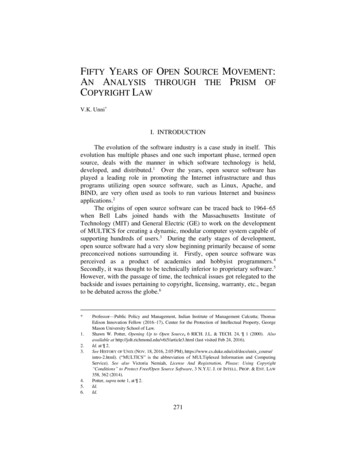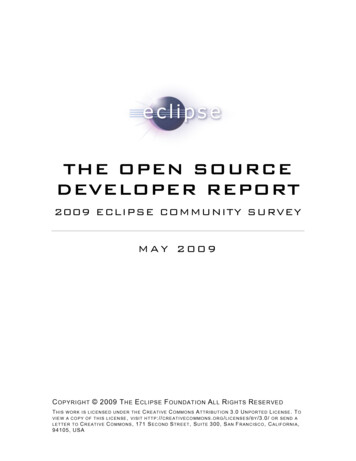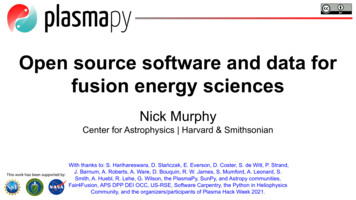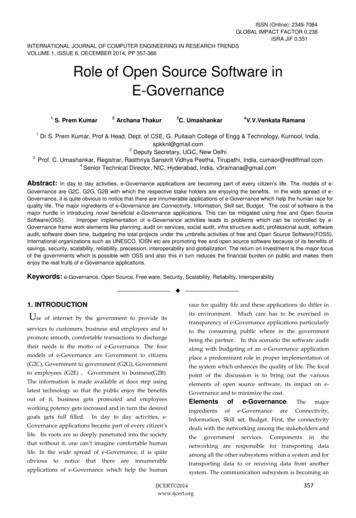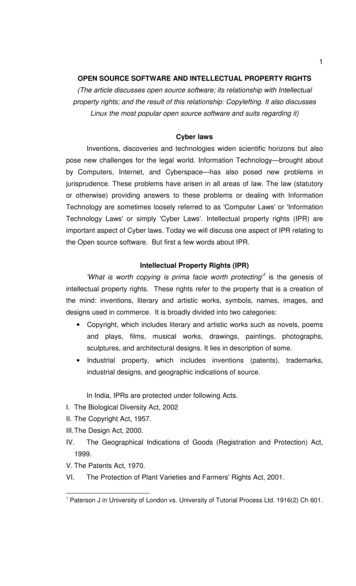
Transcription
1OPEN SOURCE SOFTWARE AND INTELLECTUAL PROPERTY RIGHTS(The article discusses open source software; its relationship with Intellectualproperty rights; and the result of this relationship: Copylefting. It also discussesLinux the most popular open source software and suits regarding it)Cyber lawsInventions, discoveries and technologies widen scientific horizons but alsopose new challenges for the legal world. Information Technology—brought aboutby Computers, Internet, and Cyberspace—has also posed new problems injurisprudence. These problems have arisen in all areas of law. The law (statutoryor otherwise) providing answers to these problems or dealing with InformationTechnology are sometimes loosely referred to as 'Computer Laws' or 'InformationTechnology Laws' or simply 'Cyber Laws'. Intellectual property rights (IPR) areimportant aspect of Cyber laws. Today we will discuss one aspect of IPR relating tothe Open source software. But first a few words about IPR.Intellectual Property Rights (IPR)'What is worth copying is prima facie worth protecting'1 is the genesis ofintellectual property rights. These rights refer to the property that is a creation ofthe mind: inventions, literary and artistic works, symbols, names, images, anddesigns used in commerce. It is broadly divided into two categories: Copyright, which includes literary and artistic works such as novels, poemsand plays, films, musical works, drawings, paintings, photographs,sculptures, and architectural designs. It lies in description of some. Industrial property, which includes inventions (patents), trademarks,industrial designs, and geographic indications of source.In India, IPRs are protected under following Acts.I. The Biological Diversity Act, 2002II. The Copyright Act, 1957.III. The Design Act, 2000.IV.The Geographical Indications of Goods (Registration and Protection) Act,1999.V. The Patents Act, 1970.VI.1The Protection of Plant Varieties and Farmers' Rights Act, 2001.Paterson J in University of London vs. University of Tutorial Process Ltd. 1916(2) Ch 601.
2VII.The semiconductor Integrated circuits Layout design Act, 2000.VIII.The Trade Marks Act, 1999.IPRs are also dealt under two more areas namely, the trade secret and theIndian Contract Act. Today we will confine ourselves to the Copyright Act as thishas bearing on open source software.Copyright: Source Code and Object CodeComputers do not understand our language. They only understand 'machinelanguage' or 'machine code' i.e. instructions which consist of a series of 0s and 1s.In the earlier days a computer program used to be written in machine code or bypunching a punchcard. The punched slot or unpunched slot indicated requisiteinformation to the computer. This processwas slow and tedious. Such aprogramme, although intelligible to the computer, was virtually unintelligible to anyone except an equally skilled programmer.(Computer Punch Card)From earlier days, the Computer scientists also devised an alternativelanguage for writing programmes, known as 'assembler language'. Theseassembler languages had advantages over writing a programme in machine codebut they still required many instructions to be written in order to achieve thesimplest tasks. A number of high-level languages—such as Basic, Fortran, Cobol,Pascal etc—have been devised in order to simplify the work of a programmer. Theuse of these high level languages enables a programmer to write a programme interms that nearly resembles ordinary English unlike those used in the lower levellanguages. They also permit complex operations for the computer to be directed bya relatively compact command. The programmes as written by a programmer areknown as the source code. When an assembler or a compiler converts it intomachine code, it is known as the object code. Generally this conversion is one wayfrom source code to the object code. However it is possible to reverse it but de-
3compilation and disassembly is time consuming and expensive.GAIM is popular proram for that loads different instant messangers (MSN orYahoo) together.(Logo of GAIM)Source code of GAIN is open.; it is known to everyone. It is written in C . A smallpart is follows.#include "proxy.h"#include "signals.h"#include "sslconn.h"#include "sound.h"struct GaimCore{char *ui;void *reserved;};static GaimCoreUiOps * ops NULL;static GaimCore* core NULL;If one reads it one can understand a few words mentioned therein and whatit is trying to say. It is kind of description of something and it amounts to literarywork within the meaning of the Copright Act and is so protected. A source code ofa computer program if it is open is a literary work within the Copyright Act.
4However often it is not disclosed and kept as trade secret. But is an object codealso protected?The Australian High Court in 1986 held that the source code is a literarywork and is protected as a copyright. But no such protection was given to theobject code. One of the judges in the majority held2,'I have not found anything that has persuaded me that [the object code]a sequence of electrical impulses in a silicon chip not capable itself ofcommunicating anything directly to a human recipient, and designed only tooperate a computer, is itself a literary work, or is the translation of a literarywork within the Copyright Act.'The aforesaid question didnot arise in India. Earlier the provisions in theCopyright Act in our country were similar; it was possible that courts might haverendered similar judgment.Amendments in the Copyright ActThe Berne convention for protection of literary and artistic works in 1986provided that computer software (object code and source code) and compilation ofdata be protected under the Copyright Acts. Agreement on Trade Related Aspectof Intellectual Property Rights (TRIPS) is part of the charter establishing WorldTrade Organisation (WTO). Every member of the WTO (and our country is amember) has to accept it. It has proceeded from the Berne convention and article10 of the TRIPS requires members to amend the laws accordingly. Since then, wehave amended the Copyright Act by two amending Acts namely Act no. 38 of 1994and Act no. 49 of 1999. These amending Acts amended section 2(o) of theCopyright Act to change the definition of the word 'literary work'. It now includescomputer programme as well as computer database. The result is that not only thecomputer programmes (subject code as well as object code) but computerdatabase is also protected as a copyright. In India infringement of a copyright is apenal offence and civil remedies (injunction damages etc.) are also available(TRIPS articles 41 to 50, 61). By the two amending Acts consequentialamendments were also made in other sections to make enforcement morerealistic.2Gibbs J. in Computer Edge Pty Ltd vs. Apple Computer Inc (1986) 161 CLR 171. Thetext of the judgement is also available at http://www.hcourt.gov.au/
5Software Licences, Open Source Software and CopyleftOne never purchases software but merely takes a licence to use it. Thereare different kinds of licenses. Software where the source code is not open and issecret is known as close source software. ‘Proprietary software’, is a close sourcesoftware, where in general the user has only limited right to use a product, on aspecific computer (sometimes with a specific power or processor) sometimes witha limited number of signed or concurrent users. ‘Freeware’ is usually used when apiece of software is given at no cost. Generally the programmes are released onlyas executables, with their source code not available.For example one candownload the Adobe Acrobat Reader as a freeware, but the software is stillproprietary and its source code is not available. ‘Shareware’ is usually distributedfree of charge for a limited period of time or for a limited use, mainly to give theuser the opportunity to test it before buying it: ‘try before you buy’ is their motto.‘Public domain software’ is software for which copyrights do not exist. Althoughthis notion is invalid in Europe (but can be understood under US law). It is oftenused for software anyone can use for any purpose, without any restriction.However, the availability of the source code is not guaranteed.Copyrights are used to protect computer software but everyone is not usingcopyrights to have rights in software. Some are using copyrights so that no oneelse may have any rights in that software; there is a new word for it: they ‘copyleft’it. Before a software may be copylefted, its source code must be disclosed. Adisclosed source software can be copylefted or non-copylefted.In order to copyleft a software, the owner first states that it is copyrightedand then adds a condition. This condition gives everyone the right to use, modify,and redistribute the source code and object code in the original or modified formonly if the aforesaid condition remains unchanged i.e. the source code and objectcode of the modified version could be further modified and distributed. Thus, thereis freedom to modify the software and anyone who redistributes the software, withor without changes, must pass along similar freedom to others. Copyleftingguarantees that every user has freedom. I will talk about copylefting in more detailsunder the heading ‘Free Source Software, GNU and GPL’. Not alldisclosedsource software is copylefted: it could be non copylefted. This depends on theterms of the licence of the software. The software where source code is disclosedand is copylefted atleast to some degree is referred to as Open Source Software
6(OSS)3;the license has to qualify some conditions. I will talk about theseconditions under the heading ‘Open Source Initiative’.Free Software, GNU and GPLCopylefted software is also known as free software. In fact the term freesoftware was used much before the term open source software was used. It allstarted in 1984 when Richard Stallman, a researcher at the MIT AI Lab, started theGNU (a recursive acronym for GNU is Not Unix) project under the umbrellaorganisation of Free Software Foundation (FSF). Stallman argued that only a fewpeople would dominate the software industry unless there was freedom to modifysoftware. The software industry could innovate and continue to grow if the sourcecode could be freely available. This became the philosophy of the FSF and theGNU project. Their philosophy as explained on their website (see below)4 is asfollows:'Free software' is a matter of liberty, not price. To understand the concept,you should think of 'free' as in 'free speech', not as in 'free beer'.Free software is a matter of the users' freedom to run, copy, distribute,study, change and improve the software. More precisely, it refers to fourkinds of freedom, for the users of the software: The freedom to run the program, for any purpose (freedom 0). The freedom to study how the program works, and adapt it to yourneeds (freedom 1). Access to the source code is a preconditionfor this. The freedom to redistribute copies so you can help your neighbor(freedom 2). The freedom to improve the program, and release your improvementsto the public, so that the whole community benefits (freedom 3).Access to the source code is a precondition for this.Richard Stallman, with the help of lawyers, drafted the General publiclicence (GPL). It contains a condition that copylefts software. Most of the softwareunder the GNU Project are under GPL. Software, under a GPL licence, is alsoAn informative study on open source software by Interchange of Data betweenAdministrations (IDA) European Commission, ‘Pooling Open Source Software’ isavailable at http://europa.eu.int/ispo/ida4Please see http://www.gnu.org/philosophy/free-sw.html3
7known as GPLed software. GPLed software can be integrated with similar GPLedsoftware but not with any proprietary programmes. However an LGPL (earlierknown as Library and now Lesser General Public License) can be integrated withalmost any kind of software including proprietary software.The GPL does not require you to release modified version. You are free tomake modifications and use them privately, without ever releasing them. Thisapplies to organizations (including companies), too; an organization can make amodified version and use it internally without ever releasing it outside theorganization. But if you release the modified version to the public in some way,then the GPL requires you to make the modified source code available to theprogramme's users. Thus, the GPL gives permission to release the modifiedprogramme in certain ways and not in other ways; but the decision, whether torelease it or not, is up to you.Open Source Initiative (OSI)The philosophy of FSF conveyed an anti business message. In the spring of1997, a group of leaders in the free software community assembled in California.They thought of a new term to describe it: Open Source Software. Open SourceInitiative (OSI) was started and a series of guidelines were drafted to describewhen software can qualify as an Open Source Software? These criteria5 are:i. Free Redistribution: The license shall not restrict any party from selling orgiving away the software as a component of an aggregate software distributioncontaining programs from several different sources. The license shall not requirea royalty or other fee for such sale.ii. Source Code: The program must include source code, and must allowdistribution in source code as well as compiled form. Where some form of aproduct is not distributed with source code, there must be a well-publicizedmeans of obtaining the source code for no more than a reasonable reproductioncost–preferably, downloading via the Internet without charge. The source codemust be the preferred form in which a programmer would modify the program.Deliberately obfuscated source code is not allowed. Intermediate forms such asthe output of a preprocessor or translator are not allowed.iii. Derived Works: The license must allow modifications and derived works, andmust allow them to be distributed under the same terms as the license of the5Please visit http://www.opensource.org/docs/definition.php
8original software.iv. Integrity of The Author's Source Code: The license may restrict source-codefrom being distributed in modified form only if the license allows the distributionof 'patch files' with the source code for the purpose of modifying the program atbuild time. The license must explicitly permit distribution of software built frommodified source code. The license may require derived works to carry a differentname or version number from the original software.v. No Discrimination Against Persons or Groups: The license must notdiscriminate against any person or group of persons.vi. No Discrimination Against Fields of Endeavour: The license must not restrictanyone from making use of the program in a specific field of endeavour. Forexample, it may not restrict the program from being used in a business, or frombeing used for genetic research.vii.Distribution of License: The rights attached to the program must apply toall to whom the program is redistributed without the need for execution of anadditional license by those parties.viii.License Must Not Be Specific to a Product: The rights attached to theprogram must not depend on the program's being part of a particular softwaredistribution. If the program is extracted from that distribution and used ordistributed within the terms of the program's license, all parties to whom theprogram is redistributed should have the same rights as those that are grantedin conjunction with the original software distribution.ix. License Must Not Restrict Other Software: The license must not placerestrictions on other software that is distributed along with the licensed software.For example, the license must not insist that all other programs distributed onthe same medium must be open-source software.x. License Must Be Technology-Neutral: No provision of the license may bepredicated on any individual technology or style of interface.Software fulfilling the aforesaid criteria are marked OSI Certified. OSI hasalso created the following graphic certification mark to mark it as an open sourcesoftware.(OSI Mark)
9A software having either of these, means that the software is beingdistributed under a license that conforms to the Open Source Definition by OSI.The following licenses have been certified by the OSI as open source software (fordetails of these licenses see the website mentioned below).66The details of these licenses are available athttp://www.opensource.org/licenses/
101. Academic Free License2. Adaptive Public License3. Apache Software License4. Apache License, 2.05. Apple Public Source License6. Artistic license7. Attribution Assurance Licenses8. New BSD license9. Common Development and Distribution License10.Common Public License 1.011.CUA Office Public License Version 1.012.EU DataGrid Software License13.Eclipse Public License14.Educational Community License15.Eiffel Forum License16.Eiffel Forum License V2.017.Entessa Public License18.Fair License19.Frameworx License20.GNU General Public License (GPL)21.GNU Library or "Lesser" General Public License (LGPL)22.Lucent Public License (Plan9)23.Lucent Public License Version 1.0224.IBM Public License25.Intel Open Source License26.Historical Permission Notice and Disclaimer27.Jabber Open Source License28.MIT license29.MITRE Collaborative Virtual Workspace License (CVW License)30.Motosoto License31.Mozilla Public License 1.0 (MPL)32.Mozilla Public License 1.1 (MPL)33.NASA Open Source Agreement 1.334.Naumen Public License35.Nethack General Public License36.Nokia Open Source License37.OCLC Research Public License 2.038.Open Group Test Suite License
1139.Open Software License40.PHP License41.Python license (CNRI Python License)42.Python Software Foundation License43.Qt Public License (QPL)44.RealNetworks Public Source License V1.045.Reciprocal Public License46.Ricoh Source Code Public License47.Sleepycat License48.Sun Industry Standards Source License (SISSL)49.Sun Public License50.Sybase Open Watcom Public License 1.051.University of Illinois/NCSA Open Source License52.Vovida Software License v. 1.053.W3C License54.wxWindows Library License55.X.Net License56.Zope Public License57.zlib/libpng licensePeople still debate whether open source software should be called freesoftware or not. FSF says there is freedom to modify the software and therefore itshould be called free software. However, apart from any other connotation, itcauses some confusion as the word ‘free’ has the meaning that ‘it is without anycost’. It could be mistakenly understood for the software that is of no cost orfreeware. I have discussed in some details about 'free software' and 'open sourcesoftware'; there is some difference between the two. However, the basic ideals ofboth are the same; it would be better if they could sort out this difference. I haveused the words ‘open source software’ rather than ‘free software’; just to avoidconfusion. This does not diminish the contribution of either of them.LinuxLinux7 is the most successful and commonly known GPLed software. It isinspired by Unix, another operating system, that was developed at AT&T’s BellLabs in the late 1960s’. At that time AT&T was a regulated monopoly and it could7Please read 'The Joy of Linux: A Gourmet Guide to Open Source' by Michael Hall & BianRiffitt for more information on Linux and its working.
12not sell computers. AT&T made Unix freely available along with source code to theuniversities and the government so that programmers could tinker with it andimprove it. By early 1980s’, Unix became a powerful and popular operating systemthough there were competing versions of the same.Andy Tanenbaum, a University Professor in Amsterdam, wrote Minix, a Unixclone, as a teaching aid for Unix. Linus Torvalds, a student of the University ofHelsinki Finland, in order to overcome the shortcomings of Minix, started writing aprogramme for a new operating system, which was based on Unix. It was Linus’Unix or simply Linux. In developing it, Linus had relied on a lot of tools that hadbeen distributed freely over the internet—especially the GCC complier distributedby GNU, a GPLed software. Many GPled softwares were also integrated withLinux. It is for this reasons many prefer to call it GNU/Linux. I have used the wordLinux as it is shorter of the two and have mentioned the name of Linus Torvaldsbecause he was the originator of the Linux. This should not be understood asundermining the contribution of GNU project or thousands of other programmerswho are responsible for the success of Linux.Linux - SuitsHowever one should know about the suits regarding use of Linux. Theiroutcome might change the future of Linux.AT&T had given one of the licenses of Unix to the University of California,Berkeley (the University) at the time when AT&T could not do computer business.The University developed and released its own version of Unix, known as theBerkeley Software Distribution (BSD). It became freely available and othercompanies incorporated it in their own products. In the meantime AT&T broke up in1984 and was allowed to do computer business. It continued to improve its ownUnix and released commercial versions of the same. The BSD version of Unixdeveloped by the University became a contender to the AT&T’s version. AT&Tsued the University for infringement of its IPR. The defence was that the Universityhad the right to distribute its version of Unix as most of the subsequent work hadbeen done by the University. In 1993 AT&T sold its Unix business to Novell who
13settled the suit with the University on undisclosed terms.It is claimed that in 1995, Novell sold the unit that marketed commercial Unixsoftware to Caldera now owned by Santa Cruz Operation (SCO). SCO filed abillion dollar law suit against IBM in Utah in 2003 alleging that IBM has, violated SCO’s trade secrets by integrating source code of Unix into Linux; lop/distribute/sell SCO’s version of Unix, called AIX.IBM has filed a counter claim in the aforesaid suit alleging that IBM’s Linux activities donot infringe any of SCO’s copyrights; It has nor breached any agreement with SCO; and It is SCO that has breached the agreement.It is not clear as to what was sold by Novell. As according to Novell, It simply sold a license to develop and then sub-license its version of Unix toother companies. It did not sell any Unix-related intellectual property to SCO. Novell and not SCO, owns the Unix copyrights and patents.SCO has filed a suit in Utah against Novell, claiming that Novell is interferingwith SCO’s business by publicly arguing that Novell, and not SCO, is actually theowner of the intellectual property in UNIX. The suit seeks damages in cash, to bedetermined in the trial. It also requests injunctions that would require Novell toassign to SCO any wrongfully obtained copyrights.
14SCO has also sent notices to 1500 corporations to obtain license from itfailing which legal proceeding would be taken against them. It has also required thecompanies to take suitable measures so that its Intellectual property rights in UNIXmay not be mixed in open source software. It has filed suits against AutoZone inNevada and DaimlerChrysler in Michigan for the alleged violations of its rights.In the aforesaid suit DaimlerChrysler applied for summary disposition. It waspartly granted 9th of August 20004 granting summary dispositionto all claimsexcept for SCO's claim for breach of contract for DaimlerChrysler's alleged failureto respond to the request for certification in a timely manner; thus dismissing mostof the claim filed by the SCO. The remaining part of the suit was dismissed on 21stDecember 2004 without prejudice to bring fresh claim on the condition that in casethe SCO refiles its claim for breach of contract for alleged failure to respond to therequest for certification in a timely manner, the SCO shall pay DaimlerChryslercosts and reasonable attorneys' fees incurred in the instant action in defendingagainst that claim after the Court's order dated 9th August, 2004 partly 'sMotionforSummary8Disposition. SCO has filed an appeal against the orders.Red Hat is a leading company selling its own version of Linux. It has filed asuit in the Delaware court for declaration that it has not infringed SCO’s copyrightsin its use and distribution of Linux.It is difficult to predict the outcome of these suits. It will depend on theevidence of the case. However, the result of the remaining suits will depend uponthe first suit filed by SCO against IBM. However many vendors (including Red Hat,HP and IBM), in order to safeguard the interests of purchasers, are indemnifingthem against claims of third parties (such as SCO) in case their (Red Hat, HP,IBM) open source products infringe any parties’ rights.8The copy of this judgement is available athttp://scofacts.org/DC-2004-12-21-B.html
15Other Successful Open Source SoftwareSome other popular copylefted open source softwares are OpenOffice.org suite (LGPL License) Mozilla Firefox and Mozilla Thunderbird (Mozilla Public License) Ximian Evolution (GPL License)Office suite provides bundle of software that are used in an office. The mostpopular office suite is Microsoft office suite. OpenOffice.org suite is similar to it.A software which permits one to access Internet is called web browser. Thereare many such software: Opera, Internet explorer etc. Mozilla Firefox is a webbrowser. Mozilla Thunderbird can send and receive emails: it can perform functionsof Outlook express. OpenOffice.org suite, Mozilla Firefox and Mozilla Thunderbirdboth can be operated in Linux as well as in Windows.Microsoft Outlook is an electronic manager. It manages ones email, calender,appointments etc. Ximian Evolution is also an electronic manager. It is similar toMicrosoft outlook however it works on Linux only.Open CoursewareOpen Source Software concept is spreading in other arenas: higher educationand is appropriately called open courseware.TechnologyMassachusetts Institute ofin Cambridge, Mass., has posted course materials for 500 of itsclasses on the Web by the end of September 2003. It plans to post online materialfor virtually all its 2,100 formal courses. The material can be used freely by anyoneand altered to meet local needs, as long as MIT is credited as the source for thematerial and no one charges for it. Similar networks have been built around thehuman genome project and its descendants; the offering by artists of free onlinemusic; and a new research-journal project called the Public Library of Science.
16Open Source Software: FutureLinus Torvalds (along with David Diamond) has written an autobiographicalbook ‘Just for Fun: the Story of an Accidental Revolutionary’. It is entertaining andoffers an insight into how the mind of a creative developer works. The last fewchapters of this book including the one on ‘Intellectual Property’ make interestingreading. He says (on pages 194, 210, and 213),‘The GPL and open source model allows for the creation of the besttechnology. It also prevents the hoarding of technology and ensures thatanyone with interest won’t be excluded from its development. So open source would rather use the legal weapon of copyright as aninvitation to join in the fun, rather than as a weapon against others. It’s stillthe same old mantra: Make Love, Not War, except on a slightly moreabstract level. Imagine an intellectual property law that actually took other people’s rightsinto account, too. Imagine IP laws that encouraged openness and sharing.Laws that say sure, you can still have your secrets, whether they betechnological or religious, but that doesn’t mandate legal protection for suchsecrecy.’Linus Torvald manages and releases Linux kernel. Will he always be thereto do so? Who would do it after him? Will there be another Linus? Many also makea point, ‘Who can afford to do professional work for nothing.’ To them, proprietarysoftware is the only solution. Windows, a proprietary software, is undoubtedly themost popular desktop for personal computers. Bill Gates in his book ‘The RoadAhead’ says (page 122),'In addition to free information, there's a lot of free software on the Internettoday, some of it quite useful. Sometimes it's commercial software givenaway as part of a marketing campaign. Other times the software has beenwritten as a graduate student project or at a government-funded lab. But Ithink consumer desire for quality, support, and comprehensiveness in
17important software applications means that the demand for commercialsoftware will continue to grow. Already many of the students and facultymembers who wrote free software at their universities are busy writingbusiness plans for start-up companies that will provide commercial versionsof their software with more features, not to mention customer support andmaintenance.'Which way will the software industry go? I am neither an expert in this field norcan I see the crystal ball. There is a suit also. However I shifted to GPLed softwarefew years ago: the reasons were practicable. GPLed software comes without anycost. And it does what I do—word processing, playing music, watching Video,surfing internet, and electronically managing my calendar—as well as any otherproprietary software. This paper as well as the presentation was made inOpenOffice.org suite over Linux machine.CONCLUSIONMichael Lewis wrote a book in 1999 entitled 'The new new thing: a SiliconValley story'. It is success story of the Silicon valley told through the biography ofJim Clarke. The most quoted line from this book is, 'The definitive smell inside aSilicon Valley start-up was of curry.' In this century, the most important issue will beof intellectual property rights. If we understand it well and harness the powers ofopen source soft
under the heading 'Free Source Software, GNU and GPL'. Not all disclosed source software is copylefted: it could be non copylefted. This depends on the terms of the licence of the software. The software where source code is disclosed and is copylefted atleast to some degree is referred to as Open Source Software


